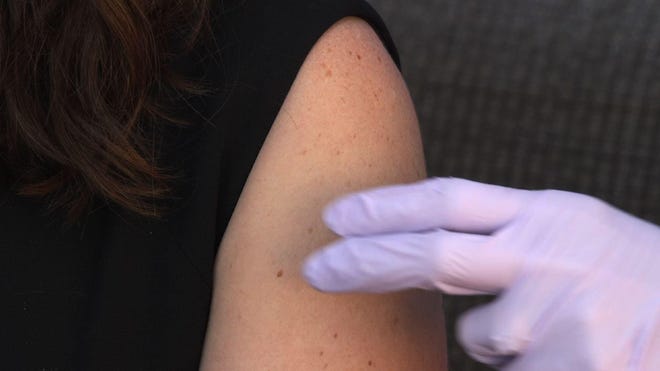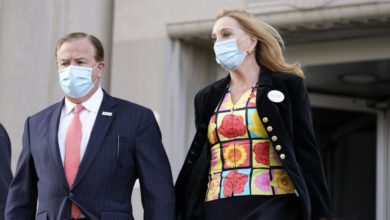
The region has now surpassed 1 million people fully inoculated against the novel coronavirus. That translates to 46.1% of the region's more than 2.2 million residents.
The news comes as the number of new COVID-19 cases in the region appears to have plateaued at a high level. The region's hospitals remain under strain, with 96% of normally staffed intensive care unit beds in use, the Health Collaborative reported Monday morning. One of every 3 ICU patients has COVID-19.
Vaccination rates have risen faster in the last two weeks in 14 of the region's 16 counties than they did the previous month, an Enquirer analysis of Centers for Disease Control and Prevention data shows. Campbell and Dearborn counties could see double-digit increases in their vaccination rates for the month if the trend continues. Only Butler and Warren counties aren't seeing faster increases in inoculations.
Rates of vaccination, based on total population and not just those currently allowed to take the vaccine under federal regulations, are highest in Northern Kentucky's three biggest counties. Tiny Ohio County, where virtually every person over age 65 was vaccinated early, barely edges out Campbell County for the percentage of its population that's fully inoculated.
Boosters:COVID-19 boosters are OK'd for some. Who is eligible and how to get one
More: Masking curbs COVID-19 in school, study shows
Kids and COVID-19: When will kids be able to get the vaccine
COVID-19 cases high in Cincinnati region
COVID-19 cases in the region continue at their highest levels since late January and early February, according to data from Johns Hopkins University's COVID-19 tracking project. See a chart of rates of new COVID-19 cases in the last seven days by county at the end of this story.
Data from the Health Collaborative, a coalition of the six health systems in the Cincinnati area, illustrates the continuing strain the cases are placing on local hospitals. To show how the fourth wave of the COVID-19 pandemic across the region has hit hospital ICUs, consider these numbers from the collaborative's Situation Dashboard:
On July 19, there were 20 COVID-19 patients in local ICUs. On Aug. 18, there were 87. On Sept. 26, the most recent date for which data is available, there were 167 – unchanged from Sept. 16.
More:Employers start to enforce vaccine mandates around Cincinnati
More: Where to find a free COVID-19 test

The region has 513 ICU beds, so the current operating status of 96% means there are 493 ICU patients. The region has the ability to operate its ICUs at 107% of capacity – or add another 56 patients.
The number of in-house COVID-19 patients on Sept. 26 was 529, down from 579 on Sept. 21 but still up 31% from Sept. 1. The patient count on Sept. 1 of 404 was up from 363 on Aug. 25 and 303 on Aug. 18.
The region's hospitals continue to have a cushion of empty medical-surgical beds. Those nearly 2,500 beds were 91% occupied on Sept. 26. On Sept. 1, they were 97% occupied.
The local seven-day rate of positive COVID-19 cases on Sept. 26 was 10.6%, down from 11.3% last week but up from 9.5% a month ago.
Where is COVID-19 especially strong now, by ZIP code?
The Health Collaborative's dashboard identifies local ZIP codes with the highest per capita rates of cases over the last 14 days.
On Sept. 26, those were:
- 45204 (Lower Price Hill, Sedamsville, Riverside and part of East Price Hill).
- 45232 (Spring Grove Village and Winton Hills).
- 45214 (West End and South Fairmount).
- 45225 (Camp Washington, Villages at Roll Hill, East Westwood, Millvale and part of North Fairmount).
- 45205 (parts of East Price Hill and West Price Hill).
All five of those ZIP codes are in the city of Cincinnati. Four of those ZIPs have had the highest level of cases in the county for the last six weeks.
The vaccination rates in each of those five ZIPs are below 40%. In 45225 and 45232, the vaccination rates are below 30%, according to the Health Collaborative's dashboard.
The ZIP code with the highest rate of cases in Hamilton County is outside the city: 45001 (Addyston). The vaccination rate there is 44%.
How COVID-19 compares to flu pandemic in deaths
Last week, the U.S. death toll from COVID-19 surpassed the number of people killed in the flu pandemic of 1918-19. Locally, 3,425 people had died of COVID-19 in the 16-county region as of Sept. 26, according to Ohio, Kentucky and Indiana health data.
Since the Cincinnati region's population of more than 2.2 million people is more than double what it was in the early 1900s, death rates make for a better comparison of the impact of the two pandemics.
The estimated death rate in Cincinnati in the flu pandemic was 451 fatalities per 100,000 residents. The region's death rate of the COVID-19 pandemic locally has been 152 deaths per 100,000, according to an Enquirer analysis of the state data.
The death rate varies across the region. The COVID-19 death rate in the city of Cincinnati is 144 per 100,000 residents, the Enquirer analysis shows. The lowest COVID-19 death rate is 94 per 100,000 residents in Campbell County; the highest, at 414 per 100,000 people, is in Gallatin County.
Source link







